
By Brendan Burke, Archaeologist and Logistical Coordinator - Lighthouse Archaeological Maritime Program
August 17, 2014
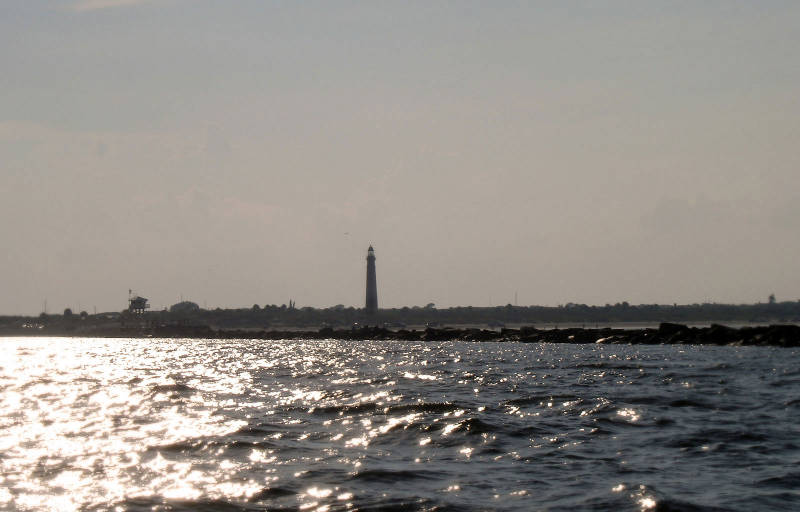
Heading into Ponce Inlet, we see the Ponce Lighthouse in the distance. This is our last transit through the inlet for the project and despite feeling melancholy that the project has come to a conclusion, we all look forward to a shower and seeing this lighthouse means hot showers! Image courtesy of Image courtesy of the Search for the Lost French Fleet of 1565 Expedition, NOAA-OER/St. Augustine Lighthouse & Museum. Download larger version (jpg, 208 KB).
Rising to a hot August sunrise, life aboard Roper had settled into a routine. Today was the boat’s third week of offshore operations and all of the hard edges had been beaten over, the rattles shaken out, and anything loose jammed into place.
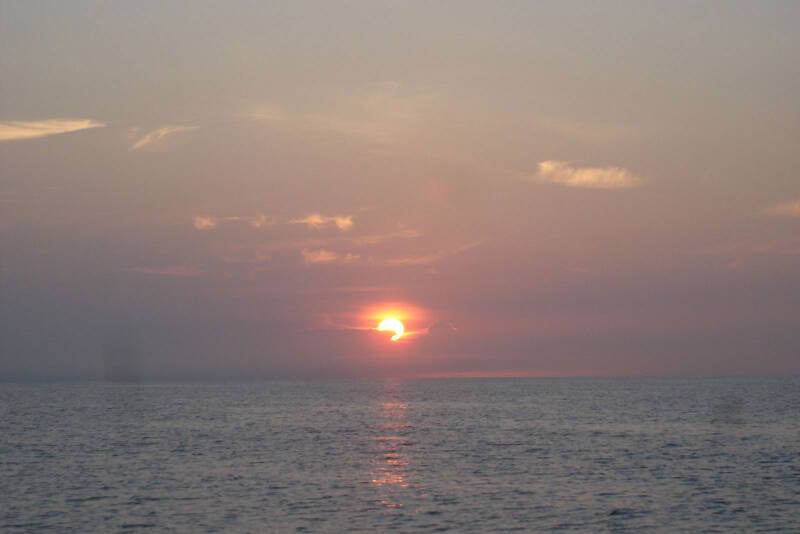
Rising over a cloud bank, the sun shines on a calm sea. The morning of August 17th breaks, our last day on site. Image courtesy of Image courtesy of the Search for the Lost French Fleet of 1565 Expedition, NOAA-OER/St. Augustine Lighthouse & Museum. Download larger version (jpg, 134 KB).
The day before, we had returned to Target 1, Drop 1 for additional probing. This target confounded divers probing it during Cruise 2, the first of the target testing cruises. Nothing yet of substance had been found even though the target displayed a substantial concentration of magnetic disturbances.
The first time we probed Target 1, Drop 1 during Cruise 2, we were at a spot we called Drop 1B. Yesterday, we resumed probing at an area we called Drop 1A, which was closer to the strongest source of magnetism than Drop 1B.
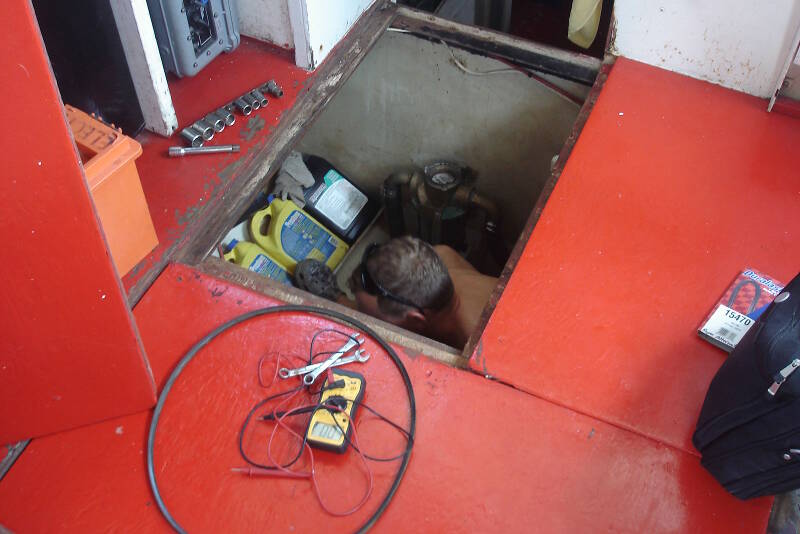
Nothing gets the day started off just right like a little time in the ‘sauna.’ This morning’s engine room check found a loose alternator belt, and so it was time to tune it up and check out the rest of the engine room as well. Image courtesy of Image courtesy of the Search for the Lost French Fleet of 1565 Expedition, NOAA-OER/St. Augustine Lighthouse & Museum. Download larger version (jpg, 255 KB).
The floating buoy marking Drop 1A teased us on the surface, played by small waves passing under it, as we ate breakfast and watched the sun slowly ignite the horizon into a peach-colored fire and then to electric blue. After coffee and a bite to eat, part of my morning routine was to check the engine room before starting up each day.
This morning’s discovery was a loose alternator belt on the main engine. A Caterpillar 3208NA, the engine has 8,200 hours on it. For a car averaging 45 miles per hour, this is equal to just under 400,000 miles. Treated right, we should get another million or so miles out of the engine. Nonetheless, the engine needs some TLC from time to time. The previous night I had changed out to our spare alternator after the primary one failed, a cracked case. This morning, it needed a little tweaking to keep the electrons flowing to our engine and house battery banks.
Oil checked and belt tight, I buttoned up the engine room. Even after a night of sitting, the engine room is still very hot in the morning. We often joke that we should paint ‘SAUNA’ on the engine room hatch in nice big curly letters with the following text in stenciled block below: MEMBERS ONLY!
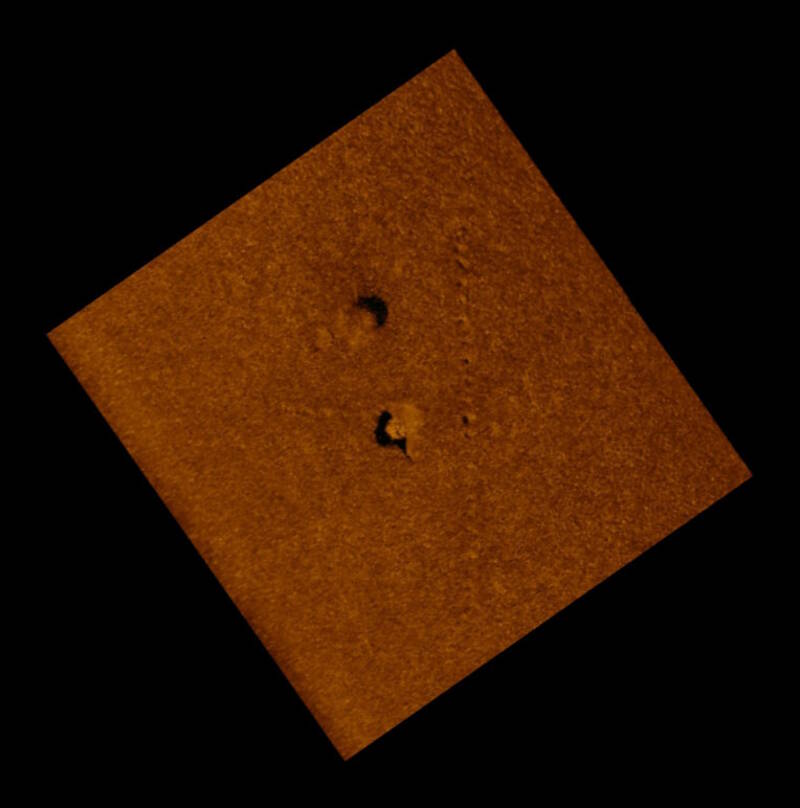
Here is a sonar image of Target E3T, where we found buried wreckage from a shrimp boat (a steel fuel tank). North is at the top of the image. You can see the excavated area that we dredged to uncover the shrimp boat tank in the center of the picture. To the right is a north-south line of probe holes, albeit eroded and partially smoothed out by the fact that they were a week old when we captured this image. To its left is a series of east-west probe holes which led to the hard return that turned out to be the buried fuel tank. We did not continue this transect of probing further east once we confirmed the wreckage was modern. The object above and to the left of the excavated fuel tank is the spoil pile from dredging, and its crescent-shaped black area is the acoustic shadow behind the pile. Compare this with the sketch archaeologists made of this site shown below. Image courtesy of Image courtesy of the Search for the Lost French Fleet of 1565 Expedition, NOAA-OER/St. Augustine Lighthouse & Museum. Download image (jpg, 44 KB).
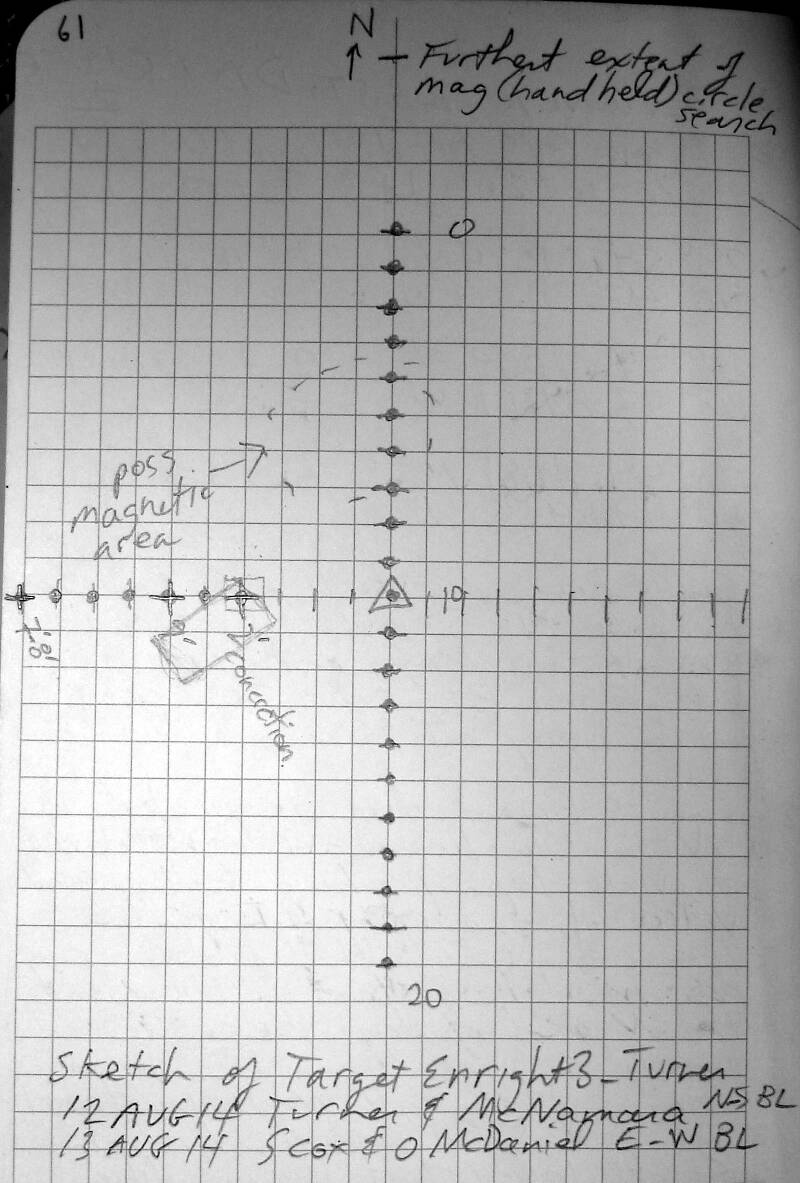
Compare this sketch of Target E3T with the sonar image above. This sketch shows the north-south transect and the east-west transect, with the solid dots representing completed probes. The fuel tank is sketched in to relative scale, though the spoil pile visible in the sonar image is not represented here. Image courtesy of Image courtesy of the Search for the Lost French Fleet of 1565 Expedition, NOAA-OER/St. Augustine Lighthouse & Museum. Download larger version (jpg, 478 KB).
Time to start up and get in gear to commit archaeology. Button on the dashboard pressed and the diesel rumbles to life. Silence of the morning broken, time to get wet. I motor the boat over to where we could pick up the stern anchor line. However, as typical, winds have shifted and we found our stern anchor too far to the south to be of any good.
So, we picked up the stern anchor to redeploy. Since our bow anchor wouldn’t allow us to back down far enough to put out the stern anchor, we swam it out with the anchor attached to a mooring buoy. The swimmers pulled the anchor out to where we directed them and, with a signal from us, cut the line holding the anchor to the buoy. When the buoy popped up, we knew it was time to haul in the slack line and get a set on the new hook.
By 0900, the dive team was on the bottom. Today’s task was to probe two, 20-meter-long lines, intersecting in the middle, at the precise location of Target 1, Drop 1. These lines run diagonal to the cruciform pattern already probed on this target. So, the goal is to have a pattern that looks like a wheel with all of the spokes and no rim, or a giant asterisk. The discovery the evening before of nylon line, shrimp netting, and composite cable led us to believe that we may be dealing with a ‘hang.’ Hangs are debris on the ocean bottom that snag fishing nets, lines, and anchors. It is possible that this net debris has been entangled on historic wreckage, like a French shipwreck, and is disguised as modern trash.
After 93 minutes, the dive team surfaced. Despite having probed another 41 holes, nothing more was found to further identify the magnetic target. We know that there is more there, but just can’t get to it because of its buried depth, or for some reason missed it in the ‘swiss-cheezing’ of the magnetic target by probing. However, time was drawing short and we needed to spend the balance of the day gathering some final project data. The diving light was now extinguished, all hands onboard, stow your diving gear, and re-rig for sonar ops!
The final part of the mission was to deploy the sidescan sonar to capture and image of each site that we worked on. We draw maps of our probe lines on the bottom and probe intervals, but there is nothing like an acoustic ‘picture’ of the bottom to show you what you did when you can’t see the whole pattern at once.
So, down to the southern end we went and, for the next several hours, towed the sidescan sonar over each target multiple times. Sidescan imaging is a lot like photography. You can take many pictures, but usually only a few are really good. And so it went, motoring back and forth over the targets, trying to get the best image.
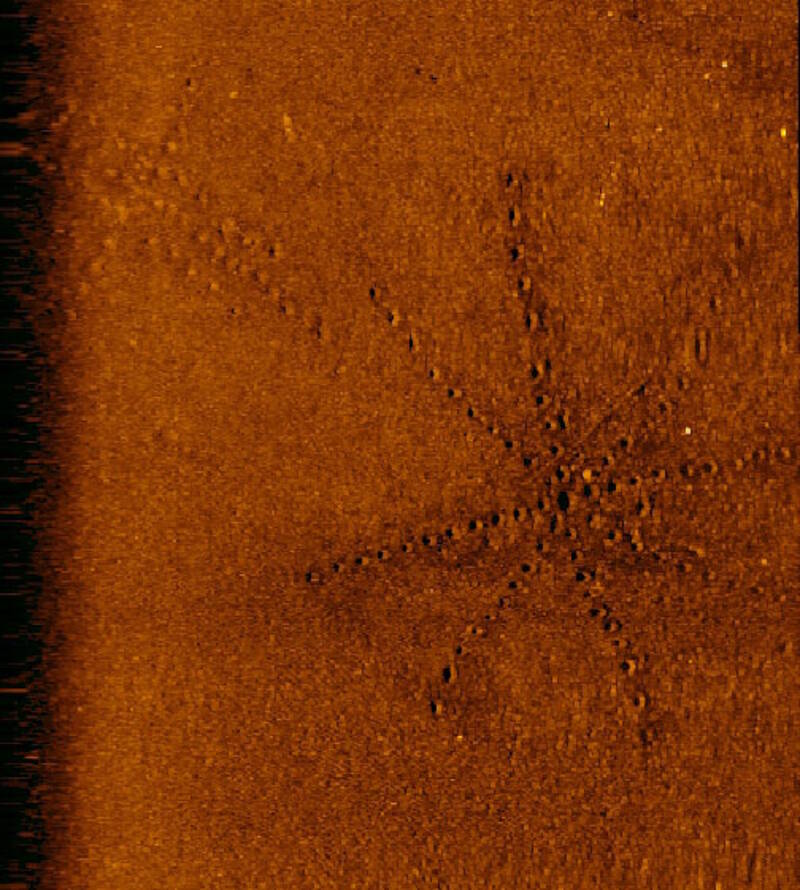
Target 1 saw a number of “drops” or testing areas and was our most complex magnetic target, receiving the most amount of attention. North is towards the top left corner. You can see two areas of exploration here in this sonar image. Drop 1B, probed August 10, is at the top left of the image, and Drop 1A is the asterisk or wheel-like series of probes at the center right. Shrimp trawling gear was found near the center of this target, the faint line above the ‘hub’ of the wheel at Drop 1A is a piece of modern line. Most of this gear was buried too deeply to determine whether or not it was simply a mass of modern fishing gear, or a shrimp net hung on an ancient wreck. Image courtesy of Image courtesy of the Search for the Lost French Fleet of 1565 Expedition, NOAA-OER/St. Augustine Lighthouse & Museum. Download image (jpg, 118 KB).
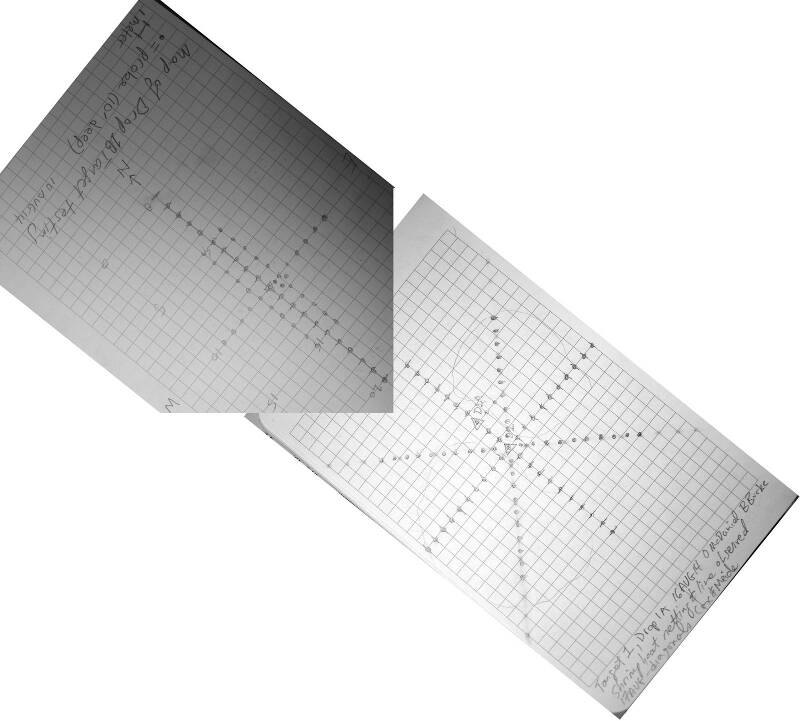
Sketches of the probes undertaken at Target 1, Drop 1B (upper left) and Drop 1A (lower right), rotated and joined together to match the orientation of the sonar image seen above. Image courtesy of Image courtesy of the Search for the Lost French Fleet of 1565 Expedition, NOAA-OER/St. Augustine Lighthouse & Museum. Download larger version (jpg, 227 KB).
And so the mystery persists. We planned our mission to the moon and did it. The boldest mission with the most ancient goal, to find a lost fleet from almost half a millennia ago. The voice of France was quieted along that stretch of beach from St. Augustine to Canaveral, the voice of empire, of conquest. In its place, Spanish took root and held dominion for longer than English has wagged the tongues of modern inhabitants.
The struggle between men, and a struggle between man and nature, took place here. Somewhere below the quiet sands of Florida the ancient bones lie of the Trinité and her small fleet, memorial to an age of exploration where empires were forged by the cross and sword.
The reason fishing is called fishing is because you don’t always catch a fish. If it were that way, we would call it ‘catching.’ We are encouraged by our findings from this year. We may not have a bronze culverin (type of cannon) with a fleur-de-lis on it, but we know a lot of places that it doesn’t exist.
Until this summer, no one had explored that stretch of coastline for the lost French Fleet of 1565. LAMP now has. We don’t say that to thrust our sword in the sand, we say that because, like many other groups and people, we are dedicated to discovering, protecting, and presenting Florida’s history.
The chapter of France versus Spain here on the First Coast is one of the most important in our collective history. We hope our research, our mission, is as inspiring to you as it is to us. Thanks for reading along and joining the St. Augustine Lighthouse here as one of NOAA’s proud Ocean Explorers.